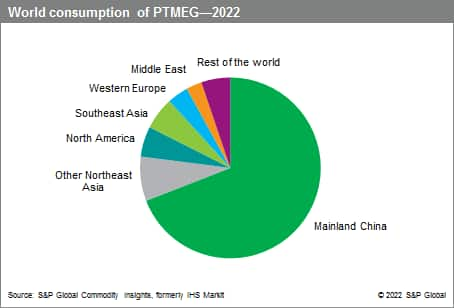Published November 2022
Polytetramethylene ether glycol (PTMEG) is a waxy, white solid that melts to a clear, colorless, viscous liquid near room temperature. PTMEG is produced by the catalyzed polymerization of tetrahydrofuran (THF). Spandex production accounts for the bulk of global PTMEG consumption. Other end uses include polyurethane elastomers (thermoplastic polyurethanes, cast urethane elastomers, and urethane adhesives, sealants, and surface coatings) and copolyester-ether elastomers.
In Northeast Asia (mainland China, Japan, South Korea, and Taiwan), Southeast Asia, the Middle East, the Indian Subcontinent, and Latin America, spandex production drove the PTMEG consumption in 2022. In North America and Western Europe, nonfiber polyurethane applications were the major end uses for PTMEG. Worldwide PTMEG consumption is forecast to grow at an average of about 5–6% over the next five years.
The following pie chart shows world consumption of PTMEG:

The majority of new PTMEG plants and capacity expansions have taken place in mainland China to supply the rapidly growing market for spandex. Mainland Chinese PTMEG production capacity will continue to expand through 2027 to support the spandex production developments.
For more detailed information, see the table of contents, shown below.
S&P Global’s Chemical Economics Handbook – Polytetramethylene Ether Glycol (PTMEG) is the comprehensive and trusted guide for anyone seeking information on this industry. This latest report details global and regional information, including

Key Benefits
S&P Global’s Chemical Economics Handbook – Polytetramethylene Ether Glycol (PTMEG) has been compiled using primary interviews with key suppliers and organizations, and leading representatives from the industry in combination with S&P Global’s unparalleled access to upstream and downstream market intelligence and expert insights into industry dynamics, trade, and economics.
This report can help you
- Identify trends and driving forces influencing chemical markets
- Forecast and plan for future demand
- Understand the impact of competing materials
- Identify and evaluate potential customers and competitors
- Evaluate producers
- Track changing prices and trade movements
- Analyze the impact of feedstocks, regulations, and other factors on chemical profitability


















